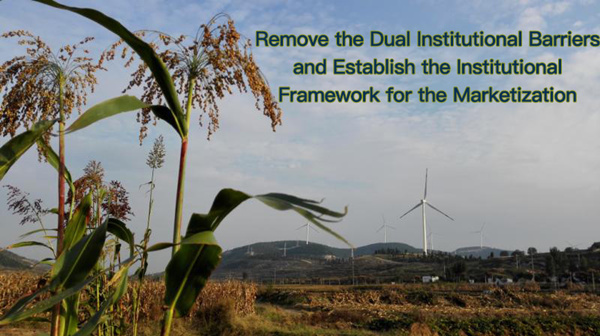Remove the Dual Institutional Barriers Relating to Rural Land through Institutional Arrangements and Establish the Institutional Framework for the Marketization of Rural Collective Land Designated for Business-related Construction Projects
Mar 26,2018

2018-2-5
In the process of rural land system reform, we need to further remove the dual institutional barriers relating to land system, make relevant institutional arrangements, establish a unified market trading system, lay equal stress on land supply channels relevant to the collective land designated for business-related construction projects and land expropriation, formulate the tax policy on rural for-profit collective land designated for construction projects, improve the mortgage financing methods and supporting system, broaden the type of land for marketization, set out guidelines after the land use right becomes due and build regional coordination mechanism in light of local conditions.
First, some pilot projects on rural for-profit collective land for marketization have made some achievements. 1. The rural for-profit collective land has made remarkable progress in realizing the same right and same price for land of different ownership, activating assets, allocating resources and joint sharing of benefits. 2. The marketization of rural for-profit collective land does not change the collective ownership of land, which could reduce the cost of land compared with land expropriation. 3. Compared with land expropriation, the farmers have regained the initiative in the process of marketization of rural for-profit collective land, thus the conflicts in land expropriation have been greatly alleviated.
Second, some institutional arrangements remain to be fleshed out relating the marketization of rural for-profit collective land. 1. The marketization of rural for-profit collective land for construction use is not properly coordinated with the land expropriation system and the impact of the direct marketization of collective land on land expropriation is looming up. 2. The policy on the proceeds from land marketization needs to be clarified and the relation between tax policy and adjustment payment on income from land value increase needs to be straightened out. 3. It is difficult to put into effect mortgage financing of rural for-profit collective land for construction projects. 4. The marketization of land only includes for-profit land without including non-for-profit land for construction projects and homestead. 5. There are uncertainties relating to the disposal of property rights after the land use right becomes due. 6. There are imbalanced proceeds for land marketization between different villages.
Third, we need to remove the dual institutional barriers relating to land system, make relevant institutional arrangements and build an institutional framework for the marketization of rural for-profit collective land for construction projects. To ensure a proper approach toward such a reform, we need to fully refer to the existing practical experience, promote the reform coordinately, remove the dual barriers to land system, build an institutional framework for the marketization of rural collective land so as to pave the way for implementing the relevant arrantements. 1. We need to remove the dual land system barriers and build a market trading system in which the collective construction land and the state-owned construction land could share the same platform and follow the same rules for market operation. 2. We need to make relevant institutional arrangements for the marketization of collective land and land expropriation so as to build a parallel channel to shore up the supply of construction land. 3. We need to make relevant institutional arrangements for sharing the tax revenue and added value between the marketization of collective land and state-owned land, and formulate the taxation policy for the marketization of rural for-profit collective land for construction use. 4. We need to make relevant institutional arrangements for the mortgage financing system channel between the collective land and state-owned land both for construction purposes and further improve the mortgage financing methods and supporting systems of for-profit collective land for construction projects. 5. We need to make overall institutional arrangements for the marketization of for-profit collective land for construction use, idle non-for-profit construction land and homestead, and expand the land type of rural collective construction land for marketization. 6. We need to make relevant institutional arrangements for the renewal of property rights between collective construction land and state-owned construction land and make the guidelines for rural collective construction land after the land use right becomes due. 7. We need to make relevant arrangements to narrow the institutional differences between collective economies in the same region due to related planning or some other factors, and establish a regional coordination mechanism in light of local conditions for the marketization of rural collective land for construction projects.














